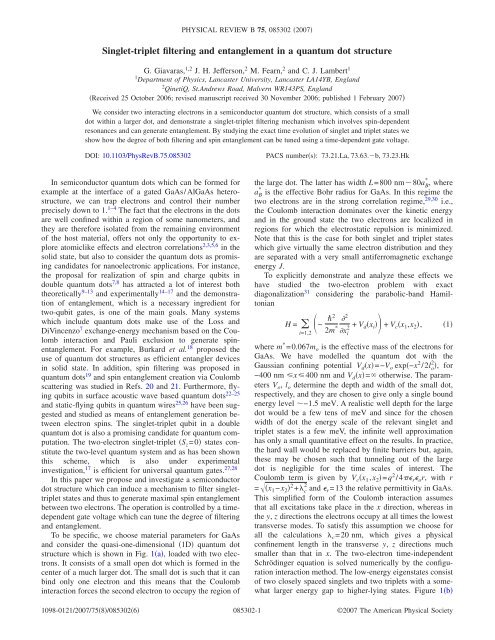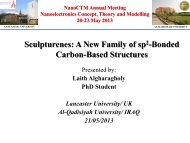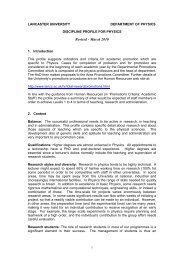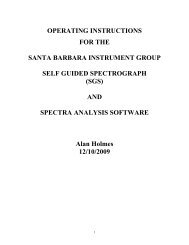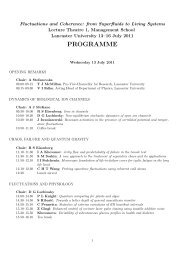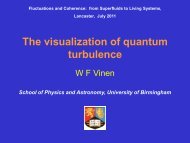Singlet-triplet filtering and entanglement in a quantum dot structure
Singlet-triplet filtering and entanglement in a quantum dot structure
Singlet-triplet filtering and entanglement in a quantum dot structure
You also want an ePaper? Increase the reach of your titles
YUMPU automatically turns print PDFs into web optimized ePapers that Google loves.
PHYSICAL REVIEW B 75, 085302 2007<strong>S<strong>in</strong>glet</strong>-<strong>triplet</strong> <strong>filter<strong>in</strong>g</strong> <strong>and</strong> <strong>entanglement</strong> <strong>in</strong> a <strong>quantum</strong> <strong>dot</strong> <strong>structure</strong>G. Giavaras, 1,2 J. H. Jefferson, 2 M. Fearn, 2 <strong>and</strong> C. J. Lambert 11 Department of Physics, Lancaster University, Lancaster LA14YB, Engl<strong>and</strong>2 Q<strong>in</strong>etiQ, St.Andrews Road, Malvern WR143PS, Engl<strong>and</strong>Received 25 October 2006; revised manuscript received 30 November 2006; published 1 February 2007We consider two <strong>in</strong>teract<strong>in</strong>g electrons <strong>in</strong> a semiconductor <strong>quantum</strong> <strong>dot</strong> <strong>structure</strong>, which consists of a small<strong>dot</strong> with<strong>in</strong> a larger <strong>dot</strong>, <strong>and</strong> demonstrate a s<strong>in</strong>glet-<strong>triplet</strong> <strong>filter<strong>in</strong>g</strong> mechanism which <strong>in</strong>volves sp<strong>in</strong>-dependentresonances <strong>and</strong> can generate <strong>entanglement</strong>. By study<strong>in</strong>g the exact time evolution of s<strong>in</strong>glet <strong>and</strong> <strong>triplet</strong> states weshow how the degree of both <strong>filter<strong>in</strong>g</strong> <strong>and</strong> sp<strong>in</strong> <strong>entanglement</strong> can be tuned us<strong>in</strong>g a time-dependent gate voltage.DOI: 10.1103/PhysRevB.75.085302PACS numbers: 73.21.La, 73.63.b, 73.23.HkIn semiconductor <strong>quantum</strong> <strong>dot</strong>s which can be formed forexample at the <strong>in</strong>terface of a gated GaAs/AlGaAs hetero<strong>structure</strong>,we can trap electrons <strong>and</strong> control their numberprecisely down to 1. 1–4 The fact that the electrons <strong>in</strong> the <strong>dot</strong>sare well conf<strong>in</strong>ed with<strong>in</strong> a region of some nanometers, <strong>and</strong>they are therefore isolated from the rema<strong>in</strong><strong>in</strong>g environmentof the host material, offers not only the opportunity to exploreatomiclike effects <strong>and</strong> electron correlations 2,3,5,6 <strong>in</strong> thesolid state, but also to consider the <strong>quantum</strong> <strong>dot</strong>s as promis<strong>in</strong>gc<strong>and</strong>idates for nanoelectronic applications. For <strong>in</strong>stance,the proposal for realization of sp<strong>in</strong> <strong>and</strong> charge qubits <strong>in</strong>double <strong>quantum</strong> <strong>dot</strong>s 7,8 has attracted a lot of <strong>in</strong>terest boththeoretically 9–13 <strong>and</strong> experimentally 14–17 <strong>and</strong> the demonstrationof <strong>entanglement</strong>, which is a necessary <strong>in</strong>gredient fortwo-qubit gates, is one of the ma<strong>in</strong> goals. Many systemswhich <strong>in</strong>clude <strong>quantum</strong> <strong>dot</strong>s make use of the Loss <strong>and</strong>DiV<strong>in</strong>cenzo 7 exchange-energy mechanism based on the Coulomb<strong>in</strong>teraction <strong>and</strong> Pauli exclusion to generate sp<strong>in</strong><strong>entanglement</strong>.For example, Burkard et al. 18 proposed theuse of <strong>quantum</strong> <strong>dot</strong> <strong>structure</strong>s as efficient entangler devices<strong>in</strong> solid state. In addition, sp<strong>in</strong> <strong>filter<strong>in</strong>g</strong> was proposed <strong>in</strong><strong>quantum</strong> <strong>dot</strong>s 19 <strong>and</strong> sp<strong>in</strong> <strong>entanglement</strong> creation via Coulombscatter<strong>in</strong>g was studied <strong>in</strong> Refs. 20 <strong>and</strong> 21. Furthermore, fly<strong>in</strong>gqubits <strong>in</strong> surface acoustic wave based <strong>quantum</strong> <strong>dot</strong>s 22–25<strong>and</strong> static-fly<strong>in</strong>g qubits <strong>in</strong> <strong>quantum</strong> wires 25,26 have been suggested<strong>and</strong> studied as means of <strong>entanglement</strong> generation betweenelectron sp<strong>in</strong>s. The s<strong>in</strong>glet-<strong>triplet</strong> qubit <strong>in</strong> a double<strong>quantum</strong> <strong>dot</strong> is also a promis<strong>in</strong>g c<strong>and</strong>idate for <strong>quantum</strong> computation.The two-electron s<strong>in</strong>glet-<strong>triplet</strong> S z =0 states constitutethe two-level <strong>quantum</strong> system <strong>and</strong> as has been shownthis scheme, which is also under experimental<strong>in</strong>vestigation, 17 is efficient for universal <strong>quantum</strong> gates. 27,28In this paper we propose <strong>and</strong> <strong>in</strong>vestigate a semiconductor<strong>dot</strong> <strong>structure</strong> which can <strong>in</strong>duce a mechanism to filter s<strong>in</strong>glet<strong>triplet</strong>states <strong>and</strong> thus to generate maximal sp<strong>in</strong> <strong>entanglement</strong>between two electrons. The operation is controlled by a timedependentgate voltage which can tune the degree of <strong>filter<strong>in</strong>g</strong><strong>and</strong> <strong>entanglement</strong>.To be specific, we choose material parameters for GaAs<strong>and</strong> consider the quasi-one-dimensional 1D <strong>quantum</strong> <strong>dot</strong><strong>structure</strong> which is shown <strong>in</strong> Fig. 1a, loaded with two electrons.It consists of a small open <strong>dot</strong> which is formed <strong>in</strong> thecenter of a much larger <strong>dot</strong>. The small <strong>dot</strong> is such that it canb<strong>in</strong>d only one electron <strong>and</strong> this means that the Coulomb<strong>in</strong>teraction forces the second electron to occupy the region ofthe large <strong>dot</strong>. The latter has width L=800 nm80a B * , wherea B * is the effective Bohr radius for GaAs. In this regime thetwo electrons are <strong>in</strong> the strong correlation regime, 29,30 i.e.,the Coulomb <strong>in</strong>teraction dom<strong>in</strong>ates over the k<strong>in</strong>etic energy<strong>and</strong> <strong>in</strong> the ground state the two electrons are localized <strong>in</strong>regions for which the electrostatic repulsion is m<strong>in</strong>imized.Note that this is the case for both s<strong>in</strong>glet <strong>and</strong> <strong>triplet</strong> stateswhich give virtually the same electron distribution <strong>and</strong> theyare separated with a very small antiferromagnetic exchangeenergy J.To explicitly demonstrate <strong>and</strong> analyze these effects wehave studied the two-electron problem with exactdiagonalization 31 consider<strong>in</strong>g the parabolic-b<strong>and</strong> HamiltonianH = i=1,2− 2 22m * 2x + V dx ii + V c x 1 ,x 2 ,where m * =0.067m o is the effective mass of the electrons forGaAs. We have modelled the <strong>quantum</strong> <strong>dot</strong> with theGaussian conf<strong>in</strong><strong>in</strong>g potential V d x=−V o exp−x 2 /2l o 2 , for−400 nm x400 nm <strong>and</strong> V d x= otherwise. The parametersV o , l o determ<strong>in</strong>e the depth <strong>and</strong> width of the small <strong>dot</strong>,respectively, <strong>and</strong> they are chosen to give only a s<strong>in</strong>gle boundenergy level −1.5 meV. A realistic well depth for the large<strong>dot</strong> would be a few tens of meV <strong>and</strong> s<strong>in</strong>ce for the chosenwidth of <strong>dot</strong> the energy scale of the relevant s<strong>in</strong>glet <strong>and</strong><strong>triplet</strong> states is a few meV, the <strong>in</strong>f<strong>in</strong>ite well approximationhas only a small quantitative effect on the results. In practice,the hard wall would be replaced by f<strong>in</strong>ite barriers but, aga<strong>in</strong>,these may be chosen such that tunnel<strong>in</strong>g out of the large<strong>dot</strong> is negligible for the time scales of <strong>in</strong>terest. TheCoulomb term is given by V c x 1 ,x 2 =q 2 /4 r o r, with r=x 1 −x 2 2 + c 2 <strong>and</strong> r =13 the relative permittivity <strong>in</strong> GaAs.This simplified form of the Coulomb <strong>in</strong>teraction assumesthat all excitations take place <strong>in</strong> the x direction, whereas <strong>in</strong>the y, z directions the electrons occupy at all times the lowesttransverse modes. To satisfy this assumption we choose forall the calculations c =20 nm, which gives a physicalconf<strong>in</strong>ement length <strong>in</strong> the transverse y, z directions muchsmaller than that <strong>in</strong> x. The two-electron time-<strong>in</strong>dependentSchröd<strong>in</strong>ger equation is solved numerically by the configuration<strong>in</strong>teraction method. The low-energy eigenstates consistof two closely spaced s<strong>in</strong>glets <strong>and</strong> two <strong>triplet</strong>s with a somewhatlarger energy gap to higher-ly<strong>in</strong>g states. Figure 1b11098-0121/2007/758/0853026085302-1©2007 The American Physical Society
GIAVARAS et al.FIG. 1. Color onl<strong>in</strong>e a Quantum <strong>dot</strong> conf<strong>in</strong><strong>in</strong>g potential <strong>and</strong>effective charge density <strong>in</strong> arbitrary units of the lowest <strong>triplet</strong>eigenstate. b Contour plot of the lowest <strong>triplet</strong> eigenstate. c Thetwo-lowest s<strong>in</strong>glet <strong>and</strong> <strong>triplet</strong> pairs.shows the lowest <strong>triplet</strong> eigenstate o T x 1 ,x 2 antisymmetric<strong>and</strong> Fig. 1c shows typical energy levels. The correspond<strong>in</strong>geffective charge density of o T x 1 ,x 2 which is derivedby <strong>in</strong>tegrat<strong>in</strong>g the two-electron charge density over thePHYSICAL REVIEW B 75, 085302 2007spatial coord<strong>in</strong>ates of one of the two electrons, i.e., T x=2q T o x,x 2 dx is shown <strong>in</strong> Fig. 1a. For this distributionone electron is bound <strong>in</strong> the small <strong>dot</strong>, whereas thesecond electron is at the left <strong>and</strong> right corners with equalprobability due to the symmetric potential. The charge densitiesassociated with all states <strong>in</strong> the low-ly<strong>in</strong>g manifold are<strong>in</strong> fact virtually identical to that shown <strong>in</strong> Fig. 1a.This can be understood from a simple Heitler-London pictureus<strong>in</strong>g one-electron states derived from a Hartreeapproximation <strong>in</strong> which we replace the trapped electron <strong>in</strong>the small <strong>dot</strong> with an effective Hartree potentialV H x=V c x,x c x 2 dx, where c x describes thes<strong>in</strong>gle-electron state of the small <strong>dot</strong>. The second electronfeels the approximate potential V H x+V d x, which for thelowest two-electron states of <strong>in</strong>terest acts as a double-wellpotential. The two lowest s<strong>in</strong>gle-electron states, − x, + xbond<strong>in</strong>g-antibond<strong>in</strong>g, of this potential have a small energysplitt<strong>in</strong>g <strong>and</strong> peak <strong>in</strong> the left <strong>and</strong> right corners. Us<strong>in</strong>g theone-electron Hartree states we may form the two lowest electronstates <strong>in</strong>dependent of sp<strong>in</strong> o x 1 ,x 2 = − x 1 c x 2 <strong>and</strong> 1 x 1 ,x 2 = + x 1 c x 2 <strong>and</strong> similarly for the nexthigher pair. With<strong>in</strong> the Hartree model this means that notonly the lowest s<strong>in</strong>glet, <strong>triplet</strong> eigenstates have a distributionof the form of Fig. 1a, but also the first excited eigenstateswhich <strong>in</strong>deed agrees with the results that we derive from theexact diagonalization. Note that even though the Hartreemodel gives great <strong>in</strong>sight <strong>in</strong>to the two-electron energies <strong>and</strong>distributions of the low-ly<strong>in</strong>g states, with remarkably littleeffort, the symmetric <strong>and</strong> antisymmetric comb<strong>in</strong>ations S,A x 1 ,x 2 = o x 1 ,x 2 ± o x 2 ,x 1 / 2 give a poor approximationto the s<strong>in</strong>glet-<strong>triplet</strong> splitt<strong>in</strong>g, with even the <strong>in</strong>correctsign. This is little improved by us<strong>in</strong>g more accurateone-electron states, e.g., from Hartree-Fock or density functionaltheory DFT, be<strong>in</strong>g a consequence of strong correlationsrequir<strong>in</strong>g accurate solutions of the two-electron problem.However, as we discuss later, the system may bedescribed accurately by an extended Hubbard model.We po<strong>in</strong>t out that the restriction to a 1D system is ma<strong>in</strong>lyfor simplicity of presentation <strong>and</strong> a 2D <strong>structure</strong>, with a numberof channels <strong>in</strong> the transverse direction, would be morerealistic for a device based on a GaAs hetero<strong>structure</strong>. However,it is straightforward to generalize the 1D results to 2Dfor rectangular <strong>dot</strong>s with high aspect ratio for which the Coulomb<strong>in</strong>teraction aga<strong>in</strong> leads to peaks <strong>in</strong> probability densitynear the opposite boundaries of the <strong>dot</strong>s <strong>and</strong> a pair of isolateds<strong>in</strong>glets <strong>and</strong> <strong>triplet</strong>s, as has been shown <strong>in</strong> Ref. 32 for arelated two-electron system <strong>in</strong> a square conf<strong>in</strong><strong>in</strong>g potential.For the dynamics that we describe below it is important to<strong>in</strong>troduce left <strong>and</strong> right states which are formed by comb<strong>in</strong><strong>in</strong>gthe two lowest eigenstates for s<strong>in</strong>glet S L = S o + S S1 , R= S o − S 1 <strong>and</strong> <strong>triplet</strong> T L =− T o + T 1 , T R = T o + T 1 unnormalized.For these states one electron is bound <strong>in</strong> the small <strong>dot</strong>whereas the second electron is localized to the correspond<strong>in</strong>gcorner as we demonstrate <strong>in</strong> Fig. 2 for the <strong>triplet</strong>.Although the effective charge density of the low-ly<strong>in</strong>gs<strong>in</strong>glets <strong>and</strong> <strong>triplet</strong>s is virtually identical, the wave functionsare quite different <strong>and</strong> give rise to effective <strong>in</strong>teractions betweensp<strong>in</strong>s, responsible for their <strong>entanglement</strong>. To demonstratehow these states can generate sp<strong>in</strong> <strong>entanglement</strong> <strong>and</strong>085302-2
SINGLET-TRIPLET FILTERING AND ENTANGLEMENT IN…PHYSICAL REVIEW B 75, 085302 2007FIG. 2. Color onl<strong>in</strong>e Effective charge density for a left <strong>and</strong>b right <strong>triplet</strong> states. The <strong>quantum</strong> <strong>dot</strong> conf<strong>in</strong><strong>in</strong>g potential is alsoshown.give rise to s<strong>in</strong>glet-<strong>triplet</strong> <strong>filter<strong>in</strong>g</strong>, we first prepare the systemsuch that one electron is located on the left with sp<strong>in</strong> up<strong>and</strong> the other <strong>in</strong> the central <strong>dot</strong> with sp<strong>in</strong> down. A suitablenonentangled state of this type may be written as a superpositionof the left s<strong>in</strong>glet <strong>and</strong> the left S z =0 <strong>triplet</strong> state,i.e., ↑↓ = S L S ↑↓ + T L T ↑↓ / 2, with the sp<strong>in</strong> eigenstates S/T ↑↓ 1,2= ↑ 1 ↓ 2 ↓ 1 ↑ 2/ 2. An approximationto this state may be obta<strong>in</strong>ed <strong>in</strong> pr<strong>in</strong>ciple by apply<strong>in</strong>g a smallsource-dra<strong>in</strong> bias V sd across the <strong>quantum</strong> <strong>dot</strong> <strong>structure</strong> toseparate the electrons with negligible overlap. The sp<strong>in</strong>s maythen be <strong>in</strong>itialized us<strong>in</strong>g magnetic fields <strong>and</strong> a microwavepulse, as suggested for scalable qubit arrays. 7,14 If V sd isremoved, then oscillations <strong>in</strong> a similar fashion to a double<strong>dot</strong> system <strong>and</strong> <strong>entanglement</strong> will develop with a typicaltime for the <strong>triplet</strong> component of the wave function on theorder of /E T 1 s, where E T =E T 1 −E T o is the energysplitt<strong>in</strong>g of the two lowest <strong>triplet</strong> eigenstates when V sd =0similarly for the s<strong>in</strong>glet. To speed up the process we canapply a time-dependent gate voltage that will tune <strong>in</strong> such away the <strong>dot</strong> potential so as to <strong>in</strong>crease this energy splitt<strong>in</strong>g.In this work we have modelled the gate voltage potentialus<strong>in</strong>g the expression V g x,t=−V p texp−x 2 /2l 2 g l g130 nm, which is driven by a triangular pulse of the formV p t =2V bT pt, 0 t T p /2− 2V bT pt +2V b , T p /2 t T p ,2FIG. 3. Effective charge density for s<strong>in</strong>glet <strong>and</strong> <strong>triplet</strong> componentsat the f<strong>in</strong>al time for a a case <strong>in</strong> the <strong>filter<strong>in</strong>g</strong> regime <strong>and</strong> bthe most general case.where T p is the period of the pulse <strong>and</strong> V b is the maximumgate voltage. We have studied the case for which the gat<strong>in</strong>grate =dV p /dt is such that to a good approximation onlythe two lowest s<strong>in</strong>glet <strong>and</strong> two lowest <strong>triplet</strong> states are <strong>in</strong>volved<strong>in</strong> the dynamics. Dur<strong>in</strong>g the first half of the cycle0tT p /2 the effect of the voltage is to decrease theeffective width of the <strong>dot</strong> thereby <strong>in</strong>creas<strong>in</strong>g the energy splitt<strong>in</strong>g<strong>and</strong> the <strong>in</strong>teraction, whereas dur<strong>in</strong>g the second half ofthe cycle T p /2tT p the process is reversed. Investigationof the optimum pulse shape <strong>and</strong> possible nonadiabaticeffects are beyond the scope of this work.The dynamics of the two electrons is governed by thetime-dependent Schröd<strong>in</strong>ger equation with the Hamiltonian1 <strong>and</strong> for a total potential V d x+V g x,t which is the sumof the <strong>dot</strong> conf<strong>in</strong><strong>in</strong>g potential <strong>and</strong> the time-dependent gatepotential. For t0, the sp<strong>in</strong> eigenstates are unchanged fors<strong>in</strong>glet or <strong>triplet</strong> components, whereas the evolution of thecorrespond<strong>in</strong>g orbital states is given directly by the solutionof the time-dependent Schröd<strong>in</strong>ger equation which is implementednumerically us<strong>in</strong>g the staggered-time algorithm proposedby Visscher. 33 The time evolution of the <strong>in</strong>itial state ↑↓ is then determ<strong>in</strong>ed by add<strong>in</strong>g the separately determ<strong>in</strong>eds<strong>in</strong>glet <strong>and</strong> <strong>triplet</strong> components. In Fig. 3 we show two examplesof the f<strong>in</strong>al electron distribution for s<strong>in</strong>glet <strong>and</strong> <strong>triplet</strong>components. Specifically, <strong>in</strong> Fig. 3a the s<strong>in</strong>glet correspondsto a good approximation to the right state, whereas the <strong>triplet</strong>corresponds to the left state. This is the ideal <strong>filter<strong>in</strong>g</strong> regimetogether with the opposite limit <strong>in</strong> which at the f<strong>in</strong>al timethe two components occupy different spatial regions. Notethat <strong>in</strong> this regime the two electrons are fully entangled providedthe measurement doma<strong>in</strong> is restricted either to the leftor right region, detect<strong>in</strong>g the s<strong>in</strong>glet or the S z =0 <strong>triplet</strong> state,respectively, which are fully entangled states. Perform<strong>in</strong>g anadditional measurement but <strong>in</strong>itializ<strong>in</strong>g the electron sp<strong>in</strong>s toa purely <strong>triplet</strong> state either of S z =±1 reveals the occupationregion of the <strong>triplet</strong> state hence offer<strong>in</strong>g a way to discrim<strong>in</strong>atebetween s<strong>in</strong>glet <strong>and</strong> <strong>triplet</strong> components. Note that <strong>in</strong> themost general case which is shown <strong>in</strong> Fig. 3b the f<strong>in</strong>al twoelectronstate is a superposition of left <strong>and</strong> right states forboth s<strong>in</strong>glet <strong>and</strong> <strong>triplet</strong> components. Clearly, a measurementwith restriction to either the left doma<strong>in</strong> or the right doma<strong>in</strong>would probe a partially entangled state.To underst<strong>and</strong> the dynamics <strong>and</strong> the difference betweens<strong>in</strong>glet <strong>and</strong> <strong>triplet</strong> components we can write the time dependence,for example of the s<strong>in</strong>glet, us<strong>in</strong>g the correspond<strong>in</strong>gtwo lowest energy states at all times, i.e., S=C S L S L +C S R S R <strong>in</strong> the left-right basis with the amplitudesC S L =e −iS cos S <strong>and</strong> C S R =ie −iS s<strong>in</strong> S . The parameters S085302-3
GIAVARAS et al.PHYSICAL REVIEW B 75, 085302 2007C R = 2P nsfP sf 1/2, 4P sf + P nsfwith P nsf =C nsf 2 <strong>and</strong> P sf =C sf 2 , thusC R = P R S + P R T 2 −4P R S P R T cos 2 1/2P R S + P RT, 5FIG. 4. Energy splitt<strong>in</strong>g of the two lowest levels for s<strong>in</strong>glet <strong>and</strong><strong>triplet</strong> components, as a function of time for one cycle <strong>in</strong> the <strong>filter<strong>in</strong>g</strong>regime.= t 0 E S 1 t+E S o tdt/2 <strong>and</strong> S = t 0 E S 1 t−E S o tdt/2depend on the two lowest energy levels <strong>and</strong> change withtime. Note that S determ<strong>in</strong>es the amount of <strong>filter<strong>in</strong>g</strong> becauseit determ<strong>in</strong>es the period of the oscillations between left <strong>and</strong>right states, whereas both S <strong>and</strong> S determ<strong>in</strong>e the degree of<strong>entanglement</strong> as we demonstrate below. In Fig. 4 we showthe energy splitt<strong>in</strong>g of the two lowest levels the energies arecalculated from <strong>in</strong>stantaneous solutions as a function oftime for one cycle <strong>in</strong> the <strong>filter<strong>in</strong>g</strong> regime which gives fullyentangled electrons <strong>in</strong> time T p 0.3 ns for V b 2.8 meV.We see that the splitt<strong>in</strong>g is larger for the s<strong>in</strong>glet <strong>and</strong> thismeans that S T , i.e., the s<strong>in</strong>glet component oscillatesfaster than the <strong>triplet</strong>. We can underst<strong>and</strong> this effect with aHartree approximation: because the small <strong>dot</strong> has only onebound energy level c , the tunnel<strong>in</strong>g time the time that theelectron <strong>in</strong> the left corner needs <strong>in</strong> order to move to the rightcorner for the <strong>triplet</strong> is longer due to the Pauli block<strong>in</strong>g.With<strong>in</strong> the Hartree model the electron <strong>in</strong> the large <strong>dot</strong> needsto tunnel through an effective double barrier due to the Coulombrepulsion from the trapped electron <strong>in</strong> the small <strong>dot</strong>,which has only one resonance energy level c +U c with U cthe Coulomb energy when both electrons occupy c <strong>and</strong>corresponds to a s<strong>in</strong>glet state. For a <strong>triplet</strong> resonance to existthe small <strong>dot</strong> needs to have at least two bound levels due tothe Pauli pr<strong>in</strong>ciple. It is worth not<strong>in</strong>g that the efficiency ofthis s<strong>in</strong>glet-<strong>triplet</strong> <strong>filter<strong>in</strong>g</strong> mechanism <strong>and</strong> the <strong>in</strong>duced <strong>entanglement</strong>has been also demonstrated <strong>in</strong> scatter<strong>in</strong>g problemsbetween a static <strong>and</strong> a fly<strong>in</strong>g qubit. 25,26To quantify the degree of <strong>entanglement</strong> which arises as aconsequence of the <strong>in</strong>teraction when the electrons are closetogether we have calculated concurrence 34 at the f<strong>in</strong>al time,from sp<strong>in</strong>-flip, P sf , <strong>and</strong> non-sp<strong>in</strong>-flip, P nsf , probabilities. Forexample, at the right region the amplitudes for these probabilitiesareC nsf = C R T S+ C R, C sf = C R T S− C R, 322which are derived by writ<strong>in</strong>g the correspond<strong>in</strong>g f<strong>in</strong>al state ↑↓ t f <strong>in</strong> the basis of sp<strong>in</strong> eigenstates. Concurrence at theright region is then given bywhere we have set P S R =C S R 2 =s<strong>in</strong> 2 S <strong>and</strong> P T R =C T R 2=s<strong>in</strong> 2 T <strong>and</strong> the relative phase = S − T . A similar expressioncan be derived for the left <strong>and</strong> even for the total region.Note that by def<strong>in</strong>ition 0C R 1 where the limit C R =0 correspondsto unentangled electrons, whereas the limit C R =1to fully entangled electrons. The measurement <strong>in</strong> the rightregion is mean<strong>in</strong>gful only when P S R 0, <strong>and</strong>/or P T R 0, i.e.,when the right state is occupied for s<strong>in</strong>glet <strong>and</strong>/or <strong>triplet</strong>. Wesee from Eq. 4 that C R =1 when P sf = P nsf or equivalentlyfrom Eq. 5 when cos =0 <strong>and</strong>/or when P S R =0 <strong>and</strong> simultaneouslyP T R 0 or vice versa.In Fig. 5 we present the dependence of probabilities,phase shift, <strong>and</strong> concurrence as a function of maximum gatevoltage V b for a fixed gat<strong>in</strong>g rate 18 meV/ns which ensuresthat to a good approximation only the two lowesteigenstates for both s<strong>in</strong>glet <strong>and</strong> <strong>triplet</strong> components are <strong>in</strong>volved<strong>in</strong>to the dynamics. Figure 5a shows the probabilitiesP S R , P T R <strong>and</strong> the absolute magnitude of the quantity cos calculatedat the f<strong>in</strong>al time vs V b . We see that the probabilitiesP S TR , P R do not oscillate for small gates voltages V b2.5 meV but rather they <strong>in</strong>crease because the energysplitt<strong>in</strong>g of the two lowest levels <strong>in</strong> this limit rema<strong>in</strong>s relativelysmall <strong>and</strong> therefore the tunnel<strong>in</strong>g time is long. Further<strong>in</strong>crease of the gate voltage <strong>in</strong>duces well-def<strong>in</strong>ed oscillations.In particular the probability of the s<strong>in</strong>glet component oscillatesfaster than the <strong>triplet</strong> because the energy splitt<strong>in</strong>g whichdeterm<strong>in</strong>es the frequency of the oscillations is larger for thes<strong>in</strong>glet. Note also that the frequency of oscillations <strong>in</strong>creaseswith gate voltage for both components follow<strong>in</strong>g the <strong>in</strong>creaseof the energy splitt<strong>in</strong>g. Figure 5b shows the concurrence C R<strong>and</strong> the sp<strong>in</strong>-flip P sf <strong>and</strong> non-sp<strong>in</strong>-flip P nsf probabilities calculatedat the f<strong>in</strong>al time. When these probabilities are equalthe <strong>entanglement</strong> is maximum whereas when one of them iszero the electrons rema<strong>in</strong> unentangled. For a gate voltageV b 2.8 meV we have an example of the ideal <strong>filter<strong>in</strong>g</strong> regimefor which P S R 0, P T R 1, <strong>and</strong> P sf = P nsf giv<strong>in</strong>g C R =1,s<strong>in</strong>ce only a <strong>triplet</strong> state occupies the right region. The genericcondition for ideal <strong>filter<strong>in</strong>g</strong> is when s<strong>in</strong> S =1 <strong>and</strong> simultaneouslys<strong>in</strong> T =0 or vice versa. Other <strong>filter<strong>in</strong>g</strong> casesnonideal which give C R =1 occur when one of the componentsis zero, say P S R =0 <strong>and</strong> the other is nonzero P T R 0, butnot, however, equal to 1. F<strong>in</strong>ally an <strong>in</strong>terest<strong>in</strong>g limit is whenP S R = P T R for which the concurrence reduces to the simple expressionC R =s<strong>in</strong> which depends only on the relativephase between s<strong>in</strong>glet <strong>and</strong> <strong>triplet</strong> components.Figure 6 presents the dependence of various quantities asa function of the pulse duration time for two different gatevoltages. As we see by compar<strong>in</strong>g Figs. 6a <strong>and</strong> 6b theperiod of the oscillations can be controlled with the value ofthe maximum gate voltage with the larger V b <strong>in</strong>duc<strong>in</strong>g fasteroscillations due to the larger energy splitt<strong>in</strong>g.085302-4
SINGLET-TRIPLET FILTERING AND ENTANGLEMENT IN…PHYSICAL REVIEW B 75, 085302 2007FIG. 5. Color onl<strong>in</strong>e Dependence at the f<strong>in</strong>altime, as a function of maximum gate voltagefor fixed gat<strong>in</strong>g rate, of a absolute value ofcos <strong>and</strong> right probabilities for s<strong>in</strong>glet <strong>and</strong> <strong>triplet</strong>components, <strong>and</strong> b concurrence, sp<strong>in</strong>-flip, <strong>and</strong>non-sp<strong>in</strong>-flip probabilities calculated for the rightregion.F<strong>in</strong>ally, we po<strong>in</strong>t out that the low-ly<strong>in</strong>g sp<strong>in</strong> states relevantto the dynamics of this entangler which <strong>in</strong>volve virtuallyidentical charge distributions at the left, center, <strong>and</strong> rightof the <strong>dot</strong> <strong>structure</strong> suggest that this charge-sp<strong>in</strong> system maybe modelled by a three-site Hubbard model of the formH eff = n L + n R + c n C + C † i, C C, + H.c.,i=L,R+ Un L,↑ n L,↓ + n R,↑ n R,↓ + U c n C,↑ n C,↓ + Vn L n C + n C n R ,6where n i = n i, = C † i, C i, , i=L,R,C, <strong>and</strong> C † i, C i, createsdestroys an electron on site i with sp<strong>in</strong> . The on-siteorbital energy for the left <strong>and</strong> right sites is <strong>and</strong> for thecentral site is c . The on-site Coulomb energy is denoted byU for the left <strong>and</strong> right sites <strong>and</strong> by U c for the central site.The nearest site Coulomb energy is V <strong>and</strong> f<strong>in</strong>ally expressesthe hopp<strong>in</strong>g between nearest sites. Note that all the physicalparameters , c ,U,U c ,V, may be estimated from theHartree approximation described earlier. Work<strong>in</strong>g with<strong>in</strong> therestricted subspace for which the two-electron basis statesconsist of six s<strong>in</strong>glets <strong>and</strong> three <strong>triplet</strong>s, we can extract thecorrect energy splitt<strong>in</strong>g of the two lowest eigenstates forboth s<strong>in</strong>glet <strong>and</strong> <strong>triplet</strong>, the correspond<strong>in</strong>g eigenstates <strong>and</strong>the antiferromagnetic exchange energy. Solution of this timedependentmodel Eq. 6 does <strong>in</strong>deed show qualitatively thesame behavior as the orig<strong>in</strong>al cont<strong>in</strong>uous problem but withconsiderable sav<strong>in</strong>g <strong>in</strong> computer time once the timedependentparameters are known. The analysis based on theeffective Hamiltonian Eq. 6 <strong>in</strong>dicates that the physical behaviorthat we have demonstrated can also be realized <strong>in</strong> atriple <strong>quantum</strong> <strong>dot</strong> <strong>structure</strong>. More importantly, the Hubbardmodel gives <strong>in</strong>sight <strong>in</strong>to the behavior of the system s<strong>in</strong>ce it isreadily mapped onto an effective charge-sp<strong>in</strong> model for thelow-ly<strong>in</strong>g manifold of two s<strong>in</strong>glets <strong>and</strong> two <strong>triplet</strong>s. In particular,for s<strong>in</strong>glets there are two processes by which an electronmay tunnel from left to right, as shown <strong>in</strong> Fig. 7. Theprocess a, that is only allowed for s<strong>in</strong>glets, has amplitudeFIG. 6. Color onl<strong>in</strong>e Dependence at the f<strong>in</strong>altime of quantities <strong>in</strong> Fig. 5 as a function ofpulse duration time for two different maximumgate voltages. a V b =2.75 meV <strong>and</strong> b V b=5 meV.085302-5
GIAVARAS et al.FIG. 7. Illustration of the two-electron sp<strong>in</strong> dynamics <strong>in</strong> a threestepprocess, I, II, III. The process a is allowed only for s<strong>in</strong>gletswhereas the process b is allowed for both s<strong>in</strong>glets <strong>and</strong> <strong>triplet</strong>s. 1 = 2 /U−V+ c −J where J is the Heisenberg exchangeenergy between an electron sp<strong>in</strong> on the central site<strong>and</strong> one on either the left or the right site. On the other h<strong>and</strong>,process b is valid for both s<strong>in</strong>glets <strong>and</strong> <strong>triplet</strong>s <strong>and</strong> hasPHYSICAL REVIEW B 75, 085302 2007amplitude 2 = 2 /− c −V. The relative rate of tunnel<strong>in</strong>gfor s<strong>in</strong>glet <strong>and</strong> <strong>triplet</strong> is thus tuned by the gate by chang<strong>in</strong>g c , s<strong>in</strong>ce mak<strong>in</strong>g c more negative the energy denom<strong>in</strong>ator <strong>in</strong> 1 decreases whereas that of 2 <strong>in</strong>creases.In summary we have presented a <strong>quantum</strong> <strong>dot</strong> <strong>structure</strong><strong>and</strong> described the two-electron distribution for the lowests<strong>in</strong>glet <strong>and</strong> <strong>triplet</strong> states. By study<strong>in</strong>g the electron dynamicsdue to a time-dependent gate voltage we showed how we can<strong>in</strong>duce a s<strong>in</strong>glet-<strong>triplet</strong> <strong>filter<strong>in</strong>g</strong> based on the Pauli block<strong>in</strong>geffect for the <strong>triplet</strong> state. This can generate full sp<strong>in</strong> <strong>entanglement</strong>with<strong>in</strong> the order of 0.3 ns. Both the degree of<strong>filter<strong>in</strong>g</strong> <strong>and</strong> <strong>entanglement</strong> can be efficiently controlled withthe gat<strong>in</strong>g rate <strong>and</strong> the maximum applied gate voltage.G.G. thanks UK EPSRC for fund<strong>in</strong>g. This work was supportedby the UK M<strong>in</strong>istry of Defence.1 L. P. Kouwenhoven, T. H. Oosterkamp, M. W. S. Danoeastro, M.Eto, D. G. Aust<strong>in</strong>g, T. Honda, <strong>and</strong> S. Tarucha, Science 278,1788 1997.2 S. Tarucha, D. G. Aust<strong>in</strong>g, T. Honda, R. J. van der Hage, <strong>and</strong> L.P. Kouwenhoven, Phys. Rev. Lett. 77, 3613 1996.3 L. P. Kouwenhoven, D. G. Aust<strong>in</strong>g, <strong>and</strong> S. Tarucha, Rep. Prog.Phys. 64, 701 2001.4 W. G. van der Wiel, S. De Franceschi, J. M. Elzerman, T.Fujisawa, S. Tarucha, <strong>and</strong> L. P. Kouwenhoven, Rev. Mod. Phys.75, 12003.5 D. H. Cobden <strong>and</strong> J. Nygard, Phys. Rev. Lett. 89, 046803 2002.6 S. Moriyama, T. Fuse, M. Suzuki, Y. Aoyagi, <strong>and</strong> K. Ishibashi,Phys. Rev. Lett. 94, 186806 2005.7 D. Loss <strong>and</strong> D. P. DiV<strong>in</strong>cenzo, Phys. Rev. A 57, 120 1998.8 L. Fedichk<strong>in</strong>, M. Yanchenko, <strong>and</strong> K. A. Valiev, Nanotechnology11, 387 2000.9 G. Burkard, D. Loss, <strong>and</strong> D. P. DiV<strong>in</strong>cenzo, Phys. Rev. B 59,2070 1999.10 J. Schliemann, D. Loss, <strong>and</strong> A. H. MacDonald, Phys. Rev. B 63,085311 2001.11 X. Hu <strong>and</strong> S. Das. Sarma, Phys. Rev. A 61, 062301 2000.12 M. Friesen, P. Rugheimer, D. E. Savage, M. G. Lagally, D. W.van der Weide, R. Joynt, <strong>and</strong> M. A. Eriksson, Phys. Rev. B 67,121301R 2003.13 P. Zhang, Q. K. Xue, X. G. Zhao, <strong>and</strong> X. C. Xie, Phys. Rev. A 66,022117 2002.14 F. H. L. Koppens, C. Buizert, K. J. Tielrooij, I. T. V<strong>in</strong>k, K. C.Nowack, T. Meunier, L. P. Kouwenhoven, <strong>and</strong> L. M. K. V<strong>and</strong>ersypen,Nature London 442, 766 2006.15 R. Hanson, L. H. Willems van Beveren, I. T. V<strong>in</strong>k, J. M. Elzerman,W. J. M. Naber, F. H. L. Koppens, L. P. Kouwenhoven, <strong>and</strong>L. M. K. V<strong>and</strong>ersypen, Phys. Rev. Lett. 94, 196802 2005.16 T. Hayashi, T. Fujisawa, H. D. Cheong, Y. H. Jeong, <strong>and</strong> Y.Hirayama, Phys. Rev. Lett. 91, 226804 2003.17 J. R. Petta, A. C. Johnson, J. M. Taylor, E. A. Laird, A. Yacoby,M. D. Luk<strong>in</strong>, C. M. Marcus, M. P. Hanson, <strong>and</strong> A. C. Gossard,Science 309, 2180 2005.18 G. Burkard, D. Loss, <strong>and</strong> E. V. Sukhorukov, Phys. Rev. B 61,R16303 2000.19 P. Recher, E. V. Sukhorukov, <strong>and</strong> D. Loss, Phys. Rev. B 63,165314 2001.20 D. S. Saraga, B. L. Altshuler, D. Loss, <strong>and</strong> R. M. Westervelt,Phys. Rev. B 71, 045338 2005.21 D. S. Saraga, B. L. Altshuler, D. Loss, <strong>and</strong> R. M. Westervelt,Phys. Rev. Lett. 92, 246803 2004.22 C. H. W. Barnes, J. M. Shilton, <strong>and</strong> A. M. Rob<strong>in</strong>son, Phys. Rev.B 62, 8410 2000.23 G. Gumbs <strong>and</strong> Y. Abranyos, Phys. Rev. A 70, 050302R 2004.24 S. Furuta, C. H. W. Barnes, <strong>and</strong> C. J. L. Doran, Phys. Rev. B 70,205320 2004.25 G. Giavaras, J. H. Jefferson, A. Ramšak, T. P. Spiller, <strong>and</strong> C. J.Lambert, Phys. Rev. B 74, 195341 2006.26 J. H. Jefferson, A. Ramšak, <strong>and</strong> T. Rejec, Europhys. Lett. 75, 7642006.27 R. Hanson <strong>and</strong> G. Burkard, cond-mat/0605576 unpublished.28 J. M. Taylor, H.-A. Engel, W. Dür, A. Yacoby, C. M. Marcus, P.Zoller, <strong>and</strong> M. D. Luk<strong>in</strong>, Nat. Phys. 1, 177 2005.29 G. W. Bryant, Phys. Rev. Lett. 59, 1140 1987.30 C. E. Creffield, W. Häusler, J. H. Jefferson, <strong>and</strong> S. Sarkar, Phys.Rev. B 59, 10719 1999.31 For two electrons x 1 , 1 ,x 2 , 2 =x 1 ,x 2 1 , 2 with symmetric antisymmetric for s<strong>in</strong>glet <strong>triplet</strong> under electronexchange. Because the Hamiltonian does not conta<strong>in</strong> any sp<strong>in</strong>dependent term we can consider only the spatial components.32 J. H. Jefferson, M. Fearn, D. L. J. Tipton, <strong>and</strong> T. P. Spiller, Phys.Rev. A 66, 042328 2002.33 P. B. Visscher, Comput. Phys. 5, 596 1991.34 W. K. Wootters, Phys. Rev. Lett. 80, 2245 1998.085302-6


